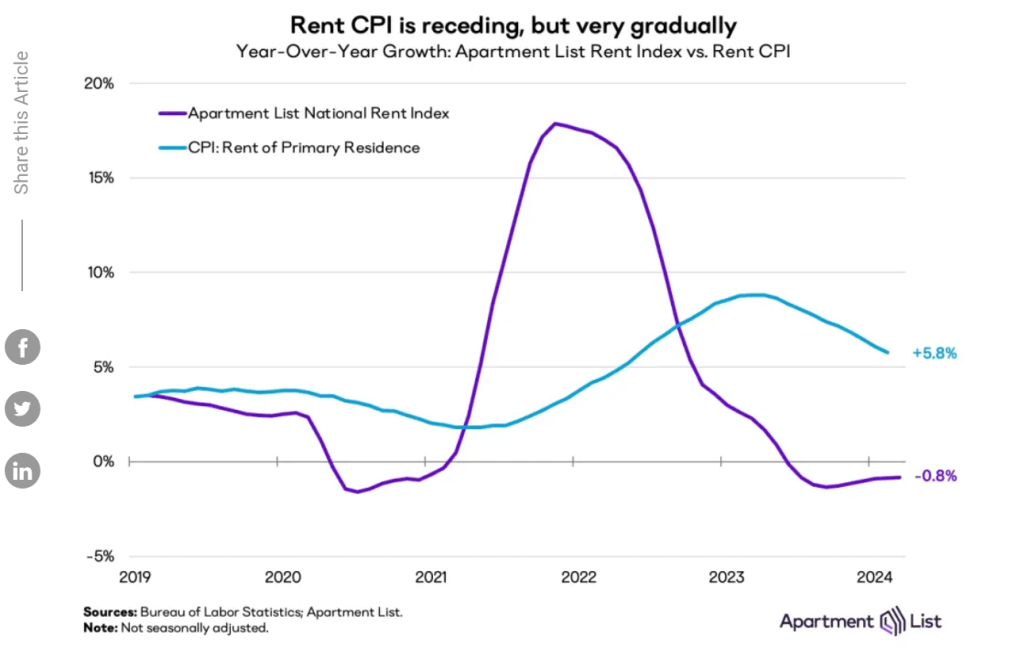The BLS releases its Consumer Price Index tomorrow. Here’s what to watch on two fronts.

In March of 2023, the CPI only rose 0.1 percent.
Energy prices fell 2.7 percent a year ago March, but now the price of energy is rising.
Energy is 6.6 percent of the CPI. This will make year-over-year progress difficult even if rent is relatively tame.
Last month, the reported year-over-year CPI increase was 3.2 percent.
Expect a year-over-year increase of 3.4 to 3.5 percent this month, but rent is a wild card. Shelter constitutes a huge 36.2 percent of the CPI.
Apartment List

Cheers to Apartment List for finally making the correct distinction between their measures and the the BLS CPI.
I have written them a few times, and their report today, Rent CPI Remains Elevated Even as Rents for New Leases Dip, states things much better.
The difference between our index and the rent component of CPI reflects the fact that the two indexes are designed to measure different concepts. The Apartment List rent index measures composition-controlled price changes for new leases, while the CPI tracks rent changes across all households. Since only a small share of households sign a new lease in any given month, it takes time for changes in market-rate asking rents to filter through to the entire market.
As a result of these differing methodologies, our index serves as an effective leading indicator for the rent component of CPI. The year-over-year growth rate of our index peaked in November 2021, leading the peak in rent CPI by 16 months. That peak was then followed by a steady decline in our measure of year-over-year rent growth, which lasted for nearly two full years before bottoming out last October. The fact that our index hit its bottom just six months ago implies that it will likely be some time before rent CPI completes its gradual descent.
That is correct. New leases are only about 9 percent of the market.
All the talk of declining rents has been based on this tiny percent of the market. Apartment List also uses unadjusted numbers whereas the BLS uses seasonal adjustments.
Seasonality
Per Investopedia, the lowest rental rates are usually found between October and April, particularly right after the December holiday season.
“Fewer people are interested in moving—the weather’s bad, schools are in session, etc. So individuals renting between the months of December and March typically find the best rental bargains.”
Most leases renew May through August. So the BLS is still be smoothing out some of last year’s increases.
Rent of primary residence has gone up at least 0.4 percent for 30 consecutive months. Reports of falling prices, except perhaps in a few select markets is nonsense.
Based off BLS smoothing and rent seasonality, we may have a few more months of sharply rising rents. But the upcoming renewals, starting May, will likely be more tame. But what will gasoline and the price of food be?
Year-Over-Year Looking Ahead
Rent will likely abate, finally. But take another look at the lead chart. There’s a decent number of monthly increases of only 0.1 percent or 0.2 percent comparisons coming up.
Unless the price of rent renewals collapses, it will be tough for the Fed to make much headway on year-over-year CPI reports especially if the price of energy shoots up.
Treasury Yields
Let’s investigate US treasury debt issuance by month and year.

For discussion, please see How Much Treasury Issuance Does the US Add Every Month to Finance Debt?
Pending in Congress
President Biden along with warmongers in both parties want to spend another $100 billion on Ukraine and Israel with no strings attached.
The Wall Street Journal constantly moans about deficit spending except for every warmongering project it sees.
That was my April 4 Hoot of the Day: WSJ Complains of Biden’s Inability to Use the Bully Pulpit
Child Tax Credit Expansion
On January 17, I asked How Much Will That GOP Deal on Child Tax Credits Really Cost?
Amazingly, House Republicans got suckered into child tax care credit expansion.
The unfortunate answer is $1.5 trillion over ten years. There’s now a chance this dikes in the Senate.
Regardless, Deficit spending has gone wild and the economy is not even in recession.
Those expecting the CPI to crash might wish to consider Biden’s energy policies, regulations, tariffs, free money handouts to students, and a big push for more unions and more government.
